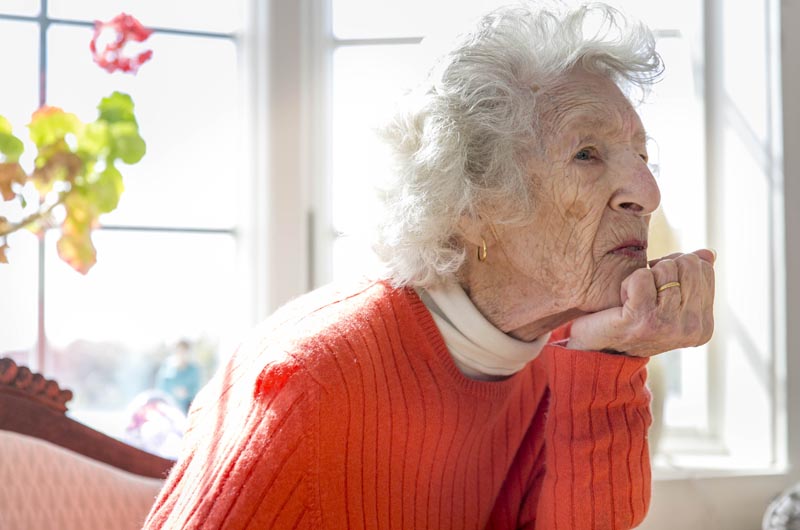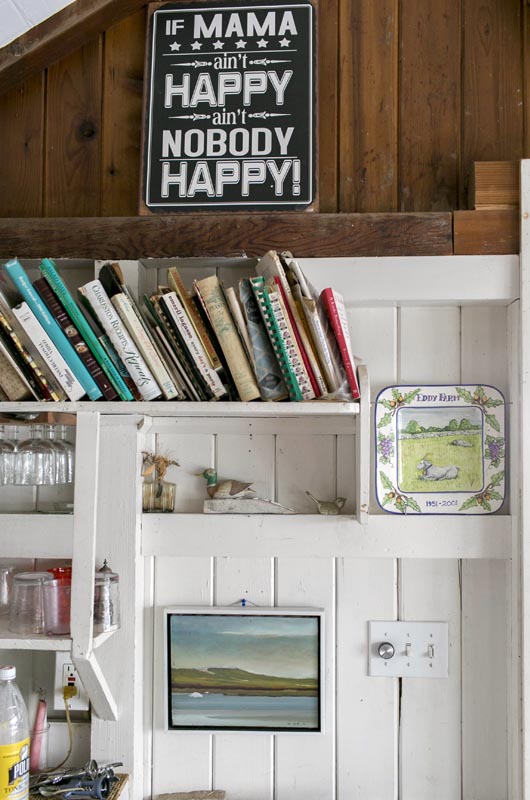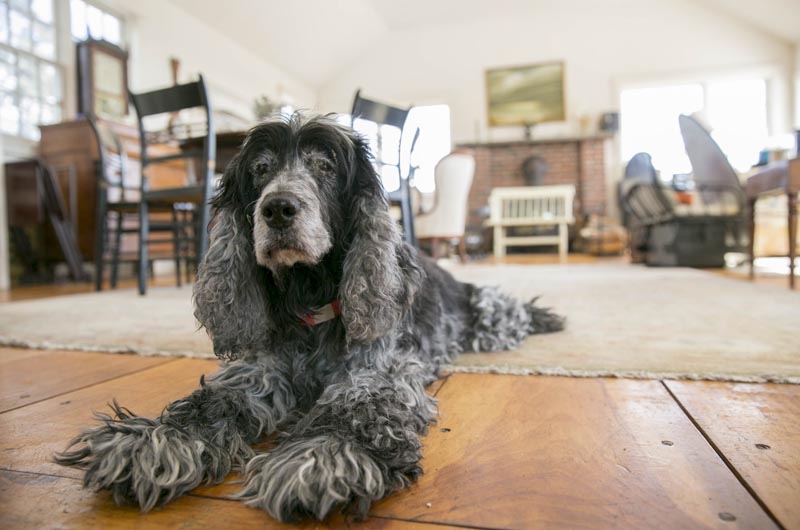Elizabeth (Betty) Eddy makes 94 look like 74. Lithe, with a wonderful head of gray curls and sparkling blue eyes, she walks through the cottage that she and her first husband, Bud Eddy, began building in 1946. The Eddy Farm, which was originally a goat farm owned by Bud Eddy’s family, is sandwiched between the Allen Farm and the Keith Farm in Chilmark. Betty and Bud started the house with two boards and a beam they carted over from Lucy Vincent Beach.
One of the later additions to the house includes a section of flat roof that this winter Betty feared would collapse under the weight of so much snow. So as part of her routine, she would climb up to the roof by way of a pair of rickety stairs with a metal dustpan in hand (a shovel was too unwieldy) to push off the snow.
“I just got up there and hung on for dear life,” she said. “Andy Palmer, my son-in-law said it best. He said, “No one’s going to find me until I’m well done.” But I have to admit that I really do like a good storm. I like to scare myself. And we have to be thankful for how really beautiful it was. It was gorgeous. So bright. All that snow. Though I honestly couldn’t do this [living alone] without the dog and the cat.”

Currently, the house has three bedrooms (four if you include a small bunk in the hall that they made for their babysitter in 1962) including a master bedroom with a tiny nonworking elevator that leads to an office below. One half of the kitchen floor is old linoleum tile and the other half, where the dining room table sits, is brick. Betty explains that instead of windows by the dining room, they used to have a garage door that they would open up when the weather was nice.
“Everything could come in and out. One time a friend, who I called Princess Flowing Tongue, was sitting there babbling on and on about something and a horse walked into the kitchen. That shut her up for about two minutes.”
“We didn’t have a bathroom, but we dined in hopeless splendor,” she adds. “Bud and I slept down here on these window seats. The kids slept upstairs in the attic.” She points to a roughly crafted ladder on one wall that used lead to the attic. “I loved watching their legs come down through the ceiling in the morning.” She laughs. “We furnished our house here from the dump. For a while, it was the most important place in our lives. And the house grew as we needed it to.”
“I am so blessed that Mr. and Mrs. Eddy, my in-laws, shared this land with us,” she adds. “Look out the window. See all those houses. That’s my family. I have my family all around me. What could be better?”
Betty first visited the Island in 1945, after she married Bud.
“I was stunned. I had no idea where Martha’s Vineyard was. How shut in was I? I had spent my summers on Long Island in Bellport. A very simple and wonderful living there. But Bud had spent his summers here in Chilmark and he said to me, ‘Now Betty, I am going to take you to see Chilmark.’ What a long trip from New York! I remember when we crossed the town line from West Tisbury into Chilmark and Bud said to me, ‘This is Chilmark.’ As though it was completely different from the town, trees and fields we had just been in.”
She laughs again. “So we started coming here in the summers. First we rented a place in Hart Haven that was called The Fleabag and it was exactly that. Dark and damp like the inside of a crypt. The first summer we came, it rained and then it rained some more. Poor Susie didn’t have a dry diaper all summer. But we had the best time. We made lifelong friends with the Cutlers, the Moores and the Peases. I’m still friends with Pat Pease. I see her all the time. She’s 97. She’s so little if you don’t look down, you’ll trip over her. Oh, but what a powerful Englishwoman.”
Betty’s dog Rufus barks. She urges him to the door. “Poor dog is as old as I am. He’s 15, can’t see and sometimes doesn’t make it outside to do his business. The weather has been hard on us this winter.”
Betty was born in 1920 in Brooklyn, N.Y.
“Those were the days when Brooklyn was still residential. There were horses on the street. I had a huge Belgian Sheperd named Tony that some people picked up and put in the zoo because they thought he was a wolf. We had to get a warrant to get the dog back.”
After Betty’s parents divorced she moved to Manhattan to live with her mother and grandparents. She went to the Dalton School and then attended the Master’s School in Dobbs Ferry.
“That was the end of my schooling. But the best thing that came from my schooling was that is how I came to know my dear dear friend Peggy Freydberg. Well, she was a long way ahead of me then, but when I came to the Vineyard, we found each other. After she lost her husband the same year I lost mine, we would have dinner every Sunday night for 20 or 25 years. Every Sunday night we’d sit in front of the fire cackling like old bats. She has been a wonderful part of my life for a long time. [Margaret Howe Freydberg passed away three days after this conversation at the age of 107]. ”
Betty explains: “You see all of us, so many of the women on this Island, live up dirt roads. The thoughts that go through your head in the winters here. Ugh! The community of women is so important here. We call each other. Are you still alive over there? We talk. Is there a young mother with a sick baby? We are responsible for each other. We have to know where each other’s houses are, what tree to turn at.”
This sense of responsibility is what inspired Betty to get involved with the Island’s Women’s Symposium, an annual spring gathering of about 300 Island women.
“Women need to get together. They need to know each other.”
Betty heads down to the office, which her second husband Bill Lidgerwood added when he moved in.
“We got together in 2003, eight years after Bud died. We’d known each other since we were 18. He was living in an assisted living facility and I told him I was not going to live in a retirement home, he would have to move here. He said that was fine, but he needed an office. So, we made one.”
Bill died four years ago and now Betty uses the office, which is located below her bedroom and is accessed through a door off the parking area of the house. Betty’s desk is tidy, with phone numbers and folders for bills and doctors. Beside the desk is a pile of boxes containing copies of Betty’s book, Letters from the Attic, which was published three years ago. Betty describes the book, which is a collection of letters to her cousin, Eve Snedaker, as being about, “The young years with children and how dreadful they were.”
For a brief time after school, Betty worked in Manhattan’s garment district and then, “was a terrible secretary for a moment.” But not long after completing school, Betty became a wife and mother. “We had a wild bunch. It was never just my children here or in our house in Connecticut. There was always a gang. The kids would come home for the summer and bring three friends. Annie once brought home an owl from Italy. I wouldn’t have wanted it to be any other way.”
During World War II and into early motherhood, Betty volunteered at the New Britain General Hospital.
“I loved being a nurse’s aid in the E.R. Blood, guts, gore. Helping people. All of it.” In fact, if Betty has one regret it is that she never went back to school to become a nurse.
“I tried volunteering at the hospital here, but they just wanted me to greet people at the door.” She waves her hand, “I don’t want that. I want to be doing something, really helping.”
When Betty’s first husband Bud retired and sold his manufacturing business, the two of them spent their winters driving around the country in a camper.
“At first he wanted to have a bed and breakfast on the shoreline. I was like, and I will be washing sheets? No! Never! So I went out with my hard-earned cash and put money down on the first camper I saw. I wanted to discover America. And we did. It was marvelous. We almost made it to our 50th wedding anniversary.”
She pauses to reflect on her life. “This weekend, my son Bill called and brought over some soup and lobster. We called Anne and Andy and they were able to come. Susie and her kids too. It all worked out.” Betty continues, “Last year, I had pancreatitis. I was in pretty bad shape. So I’m told. I guess the ambulance came to get me and then I was in the hospital lying in a hospital bed and the thought hit me out of nowhere, I am fading. I am fading fast. And I thought about my daughter Anne who was sitting beside me. I thought, I can’t do this to Anne. Then I realized I had a choice. I thought to myself, Betty, you can choose to be here or you can choose to leave. I chose to stay.”
She swats at the air with her hand. “Anyway, I’m glad I’m still here. I’m so lucky my kids are still here. Chilmark is a magical place to live. I look back and say, Elizabeth, how could you have been so smart to move here? How can I be so blessed? We live such a simple life here, but it is enough. For me, this is heaven.”
Elizabeth (Betty) Eddy
Age: 94, turns 95 on June 22.
Born: Brooklyn, N.Y. in 1920.
Martha’s Vineyard summer resident since: 1945.
Moved to Martha’s Vineyard full time: 1994.
Spouse: Widow of Bud Eddy (“We were married just shy of 50 years”) and Bill Lidgerwood (“We’d known each other since we were 18.”).
Children: Anne Palmer, Elizabeth (Lisa) White, Susan Eddy, William (Bill) Eddy.
Pets: a 15 year old dog named Rufus and a cat named Oprah (she came with the name).
Her traditional Christmas meal: “Cream chipped beef, mushrooms, mushroom soup and coffee for breakfast.”









Comments (29)
Comments
Comment policy »